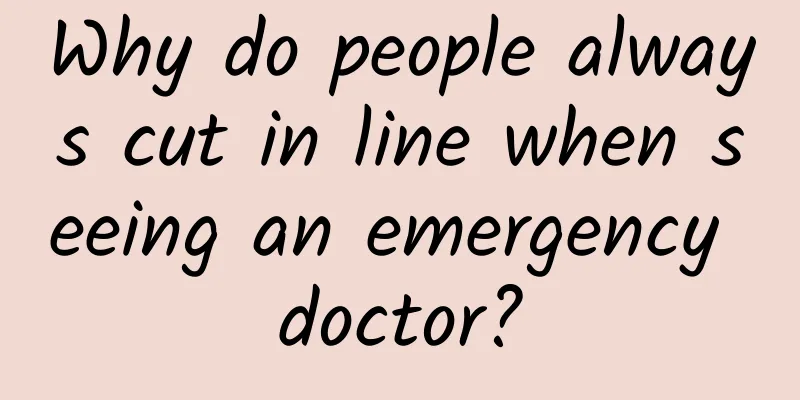Why do people always cut in line when seeing an emergency doctor?

|
Why do people always cut in line when seeing an emergency doctor? Everyone knows that if you are sick and go to the hospital, you must first register and wait in the order of your numbers. However, patients often complain that they have to wait too long in the emergency room, or even get cut in line. It has to be said that this situation does exist, but this "complaint" is actually a misunderstanding of the emergency room. The emergency room is a very special department in the hospital, and the treatment process is very different from that of the outpatient department. Today, let's talk about what kind of diseases are suitable for emergency treatment? The difference between emergency and outpatient Emergency, as the name implies, is "the diagnosis and treatment of acute diseases." Different from the appointment-based system of outpatient clinics, emergency rooms are open 24 hours a day. Their existence ensures that we can get effective and scientific treatment in the shortest possible time when we have sudden illnesses and accidental injuries. Different service objects: Emergency services are mainly for patients with acute and critical illnesses, who need doctors to quickly determine the degree of disease progression and implement treatment, otherwise their lives will be in danger. Outpatient services are mainly for patients with chronic diseases or first-time symptoms that will not threaten their lives in a short period of time. Different department settings: Emergency departments are mainly internal medicine, surgery, gynecology, and pediatrics, and for critically ill patients, there are rescue rooms, temporary observation rooms, debridement rooms, etc. When patients come to the hospital, they must undergo a pre-examination to determine the department to which the disease belongs before registering for treatment. The outpatient department settings are comprehensive. In addition to the conventional internal medicine, gynecology, and pediatrics, there are also ENT, dermatology, endocrinology, and traditional Chinese medicine. The departments of hospitals above the second level are more detailed. For example, the internal medicine department is divided into: respiratory department, cardiology department, gastroenterology department, and infectious department, and the surgery department is divided into neurosurgery, urology department, orthopedics, and cardiothoracic surgery. Comprehensive tertiary hospitals with specialty advantages will even subdivide specialty disciplines according to special diseases, such as dividing orthopedics into bone tumors, spinal surgery, and foot and ankle surgery. Generally speaking, the finer the specialty division, the more likely the patient is to receive more targeted and refined treatment. Different diagnosis and treatment thinking: The diagnosis and treatment principle of emergency and critical illness emphasizes "saving lives first and then treating diseases" - first stabilize the patient's vital signs, and then refine the treatment plan according to the disease. Saving the patient's life is the first task of emergency doctors, so the pre-examination will classify the patients according to the severity of their illness, and those with more serious illnesses will be rescued, rather than queuing up for treatment in the order of "first come, first served". What conditions require emergency room visits? Here I will teach you the “Eight-Character Mantra” for acute and critical illnesses, namely “heat, poison, injury, heart, blood, dizziness, wheezing, and pain.” Fever: Acute fever caused by various factors, with a body temperature exceeding 38.6 degrees Celsius, and obvious accompanying symptoms, such as drowsiness, chills, cough and sputum, etc. Poisoning: various types of food, drug poisoning, chemical poisoning, etc. Injury: trauma such as fractures, skin lesions, dislocations, lacerations, acute chest and abdominal organ injuries, animal scratches and bites, etc.; Heart: palpitations, chest tightness, chest pain, inability to lie flat, irregular heartbeat or slow heartbeat, etc.; Blood: heavy bleeding (more than 500 ml) due to various reasons, such as heavy blood in stool, vomiting blood, hemoptysis, and other causes; Dizziness: Sudden and intense feeling of dizziness, accompanied by limb movement disorders, severe nausea and vomiting, etc. Asthma: acute asthma attack, foreign body in the trachea, and respiratory emergencies such as shortness of breath, wheezing, chest tightness, cyanosis of lips, etc. (8) Pain: Severe pain occurring in any part of the body, such as severe headache, abdominal pain, lower back cramps, etc. If the above symptoms occur suddenly, you must go to the emergency room as soon as possible. Do not treat yourself with so-called folk remedies such as bloodletting, pinching the Ren Zhong acupoint, or taking garlic. According to surveys, the emergency departments of major hospitals in China are always overcrowded. One of the reasons for this phenomenon is that a large number of non-emergency patients occupy emergency resources, resulting in congestion in the green channel and a poor treatment environment. This is also the root cause of many conflicts and disputes between doctors and patients. The emergency department should be the last solid line of defense for critically ill patients and their life-saving straw. The author also calls on everyone to seek medical treatment on demand and leave emergency resources for truly critically ill patients. |
<<: Can stones heal themselves without treatment?
Recommend
What are the effects of love fruit? How to choose love fruit
Lover's fruit is a good fruit that combines &...
Breast hyperplasia Nipple discharge
Some women have breast hyperplasia and sometimes ...
Potassium permanganate vulva wash
Many female friends have experienced vaginal itch...
Do women have hair down there?
We all know that women generally have pubic hair ...
Thick endometrium and scanty menstruation
In daily life, many female friends are troubled b...
How to understand “highly sensitive” children?
What kind of child is a “highly sensitive” child?...
Why is the color of my period darker?
The normal color of women's menstrual blood i...
When is labia majora surgery necessary?
Women all love beauty very much, not only their e...
What to do if you have vulvar pseudocondyloma
Female friends must pay attention to their physic...
How to enlarge breasts with green color?
Having full and tall breasts to make the S-shaped...
Is yellow vaginal discharge normal in early pregnancy?
Whether a woman has gynecological diseases can be...
What to do if there is a bad smell in the vagina
What should you do if there is an odor in the vag...
Can pregnant women eat shelled almonds?
As we all know, the so-called shelled almonds are...
What are the clinical symptoms of double vagina and double uterus?
Women's reproductive organs are all single, s...
Why does a woman bleed when she goes to the toilet?
What is the reason for bleeding in women's ur...









